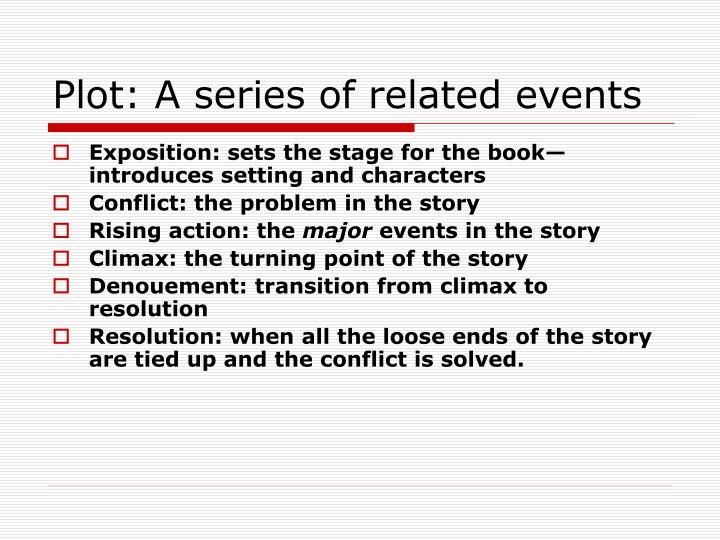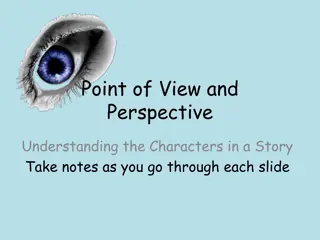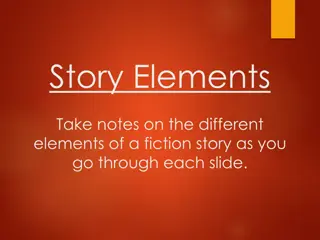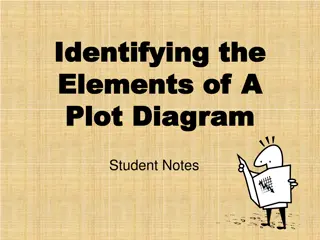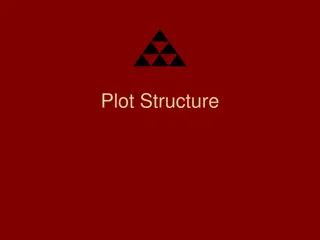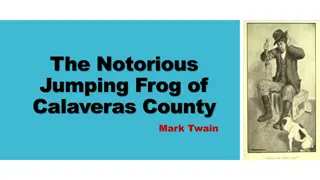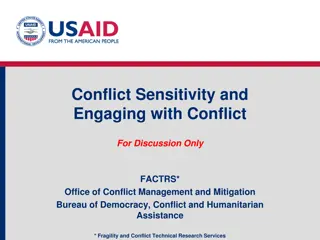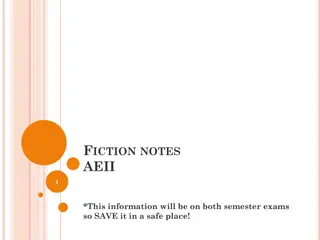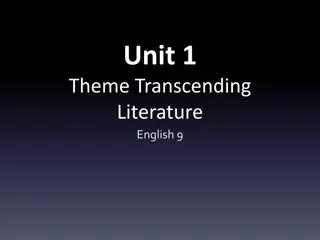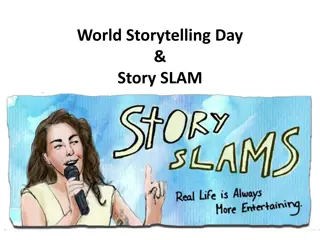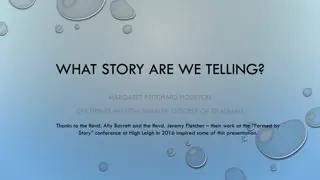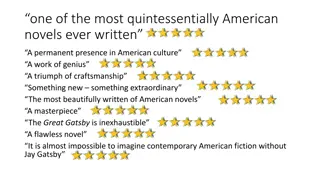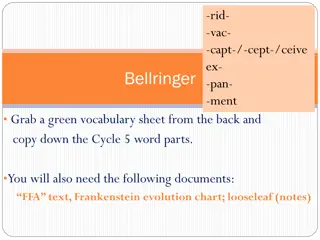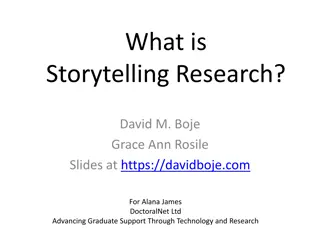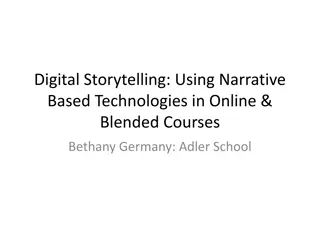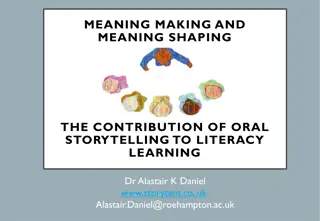Elements of Storytelling: Plot, Conflict, Point of View
Explore the key components of storytelling such as plot development, conflict types (external and internal), and various perspectives (first, second, third person omniscient). Understand how these elements shape the narrative, create suspense, and engage readers in different ways.
Download Presentation

Please find below an Image/Link to download the presentation.
The content on the website is provided AS IS for your information and personal use only. It may not be sold, licensed, or shared on other websites without obtaining consent from the author.If you encounter any issues during the download, it is possible that the publisher has removed the file from their server.
You are allowed to download the files provided on this website for personal or commercial use, subject to the condition that they are used lawfully. All files are the property of their respective owners.
The content on the website is provided AS IS for your information and personal use only. It may not be sold, licensed, or shared on other websites without obtaining consent from the author.
E N D
Presentation Transcript
Plot: A series of related events Exposition: sets the stage for the book introduces setting and characters Conflict: the problem in the story Rising action: the major events in the story Climax: the turning point of the story Denouement: transition from climax to resolution Resolution: when all the loose ends of the story are tied up and the conflict is solved.
External Conflict: character struggles with an outside force Man vs. man Man vs. nature Man vs. technology Man vs. society
Internal Conflict: character struggles with his/her own emotions Making a decision about something Guilt about a past decision
Point of View: whose perspective the story is told from Why does point-of-view matter? Influences our understanding of a situation Allows the author to fix the reader s attention on particular detail, opinion, or emotion hqdefault Determines the angle/perception of the story Mary Poppins: A delightful story about about a kind nanny who brings a family closer together.
First Person POV Narrator is a character in the story Advantage: helps the reader connect with the character The world is depicted solely through that character s eyes Something to think about: No human being has the ability to see and know EVERYTHING. First person POV challenges the reader to see beyond what the character might see I'd never given much thought to how I would die - though I'd never had reason enough in the last few months - but even if I had, I would not have imagined I would die like this. Twilight
Second Person POV Narrator seems to be having a conversation with the reader Utilizes the you pronoun When you see this in stories pay attention! Author has made a daring choice with a purpose in mind Draws the reader in by making them a participant "You have brains in your head. You have feet in your shoes. You can steer yourself any direction you choose. You re on your own. And you know what you know. And YOU are the guy who ll decide where to go." (Dr. Seuss, Oh! The Places You ll Go! 1990)
Third Person Omniscient: God-like narrator Knows the thoughts/feelings of all characters Allows the reader to see multiple perspectives Gives a more objective view of events In omniscient voice, we can flit from person to person Mr. Franka said. He scanned the rows of students, pleased to see they were paying attention. It was a good honors class this year. But some readers find that the omniscient voice doesn t allow them to develop a bond with the characters. At times, if handled poorly, it can even be jolting . I m hungry, Kelly thought. -- Sleeping Freshmen Never Lie
Third Person Limited POV Narrator is not a character in the story Reader sees the world through the eyes, ears, and mind of just one character we only know what he thinks and observes If the character doesn t see or experience it neither does the reader. At the moment when life as he had known it changed forever, Alex Morales was behind the counter at Joey's Pizza, slicing a spinach pesto pie into eight roughly equal pieces." -- the dead and the gone
Characterization: How an author gives information about the characters in a story Direct Characterization: (tell) The character is described through direct description from the author. Lennie is big and dumb. His childlike innocence allows him to take an active role in George's dream of owning farm. Lennie loves soft things and animals, which he accidentally kills because of his strength. His size combined with his mental handicap frequently put him and George in difficult situations. Of Mice and Men, Steinbeck Indirect Characterization: (show) Speech Thoughts Effects Actions Looks volunteer
Character Terms Protagonist: the leading character, hero, or heroine of a drama or other literary work Antagonist: the character who opposes or struggles with the leading character (protagonist) Static character: a character who does not change during the course of the story Static=Stays the Same Dynamic character: a character who undergoes a major change during the story Motivation: what drives a character to do what they do Trait: characteristics about the character Archetype: a type of character who repeatedly appears in stories Examples: the hero, the martyr, the villain in black, the bully, the star-crossed lovers
How does an author keep you engaged in the story? Suspense: a feeling of growing tension or excitement what might happen next? Foreshadowing Occurs when the author gives you hints about what is to come in the story
Tone: the writers attitude or feeling toward the subject Tone can often be determined by point-of-view Mood: the feeling or atmosphere of the story Created by the use of description, characterization, setting, etc. Scary Mary
Irony: the contrast between what is expected and what actually happens or exists. Mr. Play it Safe was afraid to fly. He packed his suitcase and kissed his kids goodbye. He d waited his whole life just to take that flight. And as the plane crashed down, he thought, Well isn t this nice? Used to add unexpected twists to the story More than just a coincidence Verbal irony Dramatic irony Situational irony http://t1.gstatic.com/images?q=tbn:ANd9GcQkR9pa278V43GabmqPZqqAgbS2bcVSVCekH4TGTZ-kJYu7sv8_gQ:ecx.images-amazon.com/images/I/41KjsLH-0UL._SL500_AA300_.jpg
Allusion A reference in a literary work to a person, place, or thing in history or another work of literature. Allusions are often indirect or brief references to well-known characters or events The couple danced as though they were Romeo and Juliet Should we build an ark? John asked, after it rained for 5 days straight.
